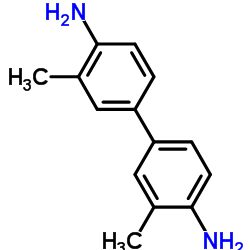3,3'-dimethylbenzidine

3,3'-dimethylbenzidine structure
|
Common Name | 3,3'-dimethylbenzidine | ||
|---|---|---|---|---|
| CAS Number | 119-93-7 | Molecular Weight | 212.290 | |
| Density | 1.1±0.1 g/cm3 | Boiling Point | 361.0±37.0 °C at 760 mmHg | |
| Molecular Formula | C14H16N2 | Melting Point | 128-131 °C(lit.) | |
| MSDS | Chinese USA | Flash Point | 205.1±26.0 °C | |
| Symbol |



GHS07, GHS08, GHS09 |
Signal Word | Danger | |
|
Evidence that 4-aminobiphenyl, benzidine, and benzidine congeners produce genotoxicity through reactive oxygen species.
Environ. Mol. Mutagen. 48(5) , 404-13, (2007) 4-Aminobyphenyl (4-Ab), benzidine (Bz), and Bz congeners were evaluated for their ability to induce genotoxicity through an oxidative mechanism. The mutagenicity of these compounds was tested in the presence and absence of Aroclor 1254-induced rat S9 mix usin... |
|
|
Biopartitioning micellar chromatography to predict mutagenicity of aromatic amines.
Eur. J. Med. Chem. 42 , 1396-402, (2007) Mutagenicity is a toxicity endpoint associated with the chronic exposure to chemicals. Aromatic amines have considerable industrial and environmental importance due to their widespread use in industry and their mutagenic capacity. Biopartitioning micellar chr... |
|
|
ortho-Substituent effects on the in vitro and in vivo genotoxicity of benzidine derivatives.
Mutat. Res. 319(1) , 19-30, (1993) Benzidine and its 3,3'-diamino, 3,3'-dimethyl, 3,3'-dimethoxy, 3,3'-difluoro, 3,3'-dichloro, 3,3'-dibromo, 3,3'-dicarbomethoxy and 3,3'-dinitro derivatives together with 2-nitrobenzidine and 3-nitrobenzidine were compared for their in vitro and in vivo genoto... |
|
|
Iron(III) oxidized nucleophilic coupling of catechol with o-tolidine/p-toluidine followed by 1,10-phenanthroline as new and sensitivity improved spectrophotometric methods for iron present in chemicals, pharmaceutical, edible green leaves, nuts and lake water samples.
Spectrochim. Acta. A. Mol. Biomol. Spectrosc. 86 , 152-8, (2012) A nucleophile formed from iron(III) oxidized catechol in 0.1M hydrochloric acid couple with o-tolidine, system 1/p-toluidine, system 2 to produce dye product, λ max 520 nm. The system 1/2 obeys Beer's law in the range 0.08-8.0 μg ml(-1) with molar absorptivit... |
|
|
Electronic, infrared, and 1HNMR spectral studies of the novel charge-transfer complexes of o-tolidine and p-toluidine with alternation pi-acceptors (3,5-dinitro benzoic acid and 2,6-dichloroquinone-4-chloroimide) in CHCl3 solvent.
Spectrochim. Acta. A. Mol. Biomol. Spectrosc. 64(3) , 778-88, (2006) The rapid interaction between o-tolidine and p-toluidine (pi-donors) with the pi-acceptors, e.g., 3,5-dinitrobenzoic acid (DNB) and 2,6-dichloroquinone-4-chloroimide (DCQ) results in the formation of 1:1 charge-transfer complexes as the final products, [(o-to... |
|
|
Formation of a carcinogenic aromatic amine from an azo dye by human skin bacteria in vitro.
Hum. Exp. Toxicol. 18(9) , 552-9, (1999) Azo dyes represent the major class of dyestuffs. They are metabolised to the corresponding amines by liver enzymes and the intestinal microflora following incorporation by both experimental animals and humans. For safety evaluation of the dermal exposure of c... |
|
|
[The role of carcinogenic aminobiphenyls in hepatocyte differentiation].
Vopr. Med. Khim. 37(6) , 50-3, (1991) Contribution of various hemoproteins to peroxidase oxidation of benzidine and its derivatives as well as effects of these substances on functional state of hepatocytes are discussed. Benzidine and its derivatives were shown to induce those forms of cytochrome... |
|
|
How accurate is the determination of blood in gastric juice? Comparison of peroxidase and porphyrin methods.
Aliment. Pharmacol. Ther. 10(3) , 333-7, (1996) Mucosal bleeding is frequently used as a measure of gastric mucosal integrity. We compared the orthotolidine method for quantifying haemoglobin in gastric juice with a method based on measurement of fluorescent porphyrins extracted from haem. We also investig... |
|
|
Intermolecular hydrogen bond complexes by in situ charge transfer complexation of o-tolidine with picric and chloranilic acids.
Spectrochim. Acta. A. Mol. Biomol. Spectrosc. 79(3) , 672-9, (2011) A two new charge transfer complexes formed from the interactions between o-tolidine (o-TOL) and picric (PA) or chloranilic (CA) acids, with the compositions, [(o-TOL)(PA)(2)] and [(o-TOL)(CA)(2)] have been prepared. The (13)C NMR, (1)H NMR, (1)H-Cosy, and IR ... |
|
|
Removal of estrogenic activity from endocrine-disrupting chemicals by purified laccase of Phlebia tremellosa.
FEMS Microbiol. Lett. 284(2) , 172-5, (2008) A white-rot basidiomycete, Phlebia tremellosa, produced a laccase that showed increased activity during degradation of phthalates. A laccase was purified through the ion exchange chromatography and preparative gel electrophoresis, and the estimated molecular ... |